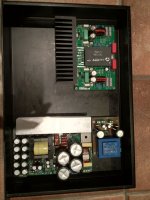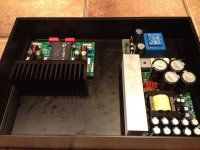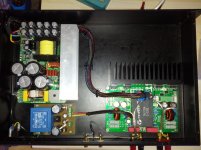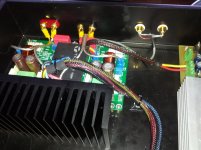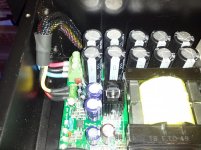Hi,
I thought I would introduce my latest build - it's been a while since I last built any kit, but like most, I've been collecting parts for years.
These are based on the rare and infamous Tripath TA0105A chips and a 2000W SMPS by Connexelectonics. The decision to use a SMPS over a conventional linear PSU was borne out of the desire for a small footprint, high-tech amp. The huge toroidal transformers that are still sat in my loft just didn't seem right some how.
This project will be built in two phases. The first is to complete two (very) simple builds as I use a bi-amp setup with a line-level electronic x-over. Phase two will be to fit a small arduino inside with a comms bus so various data will be passed back to the custom preamp (which is also in pieces in the loft awaiting TLC). From there, I'll be able to look at temperatures, remote power on/off and maybe things like speaker protection circuit alerts/history and muting. Ultimately, the idea will be to allow any equipment I build to use the same comms bus with zero-config (e.g. when I finally rebuild my CD-PRO2 player).
For now, here's some eye candy...
I thought I would introduce my latest build - it's been a while since I last built any kit, but like most, I've been collecting parts for years.
These are based on the rare and infamous Tripath TA0105A chips and a 2000W SMPS by Connexelectonics. The decision to use a SMPS over a conventional linear PSU was borne out of the desire for a small footprint, high-tech amp. The huge toroidal transformers that are still sat in my loft just didn't seem right some how.
This project will be built in two phases. The first is to complete two (very) simple builds as I use a bi-amp setup with a line-level electronic x-over. Phase two will be to fit a small arduino inside with a comms bus so various data will be passed back to the custom preamp (which is also in pieces in the loft awaiting TLC). From there, I'll be able to look at temperatures, remote power on/off and maybe things like speaker protection circuit alerts/history and muting. Ultimately, the idea will be to allow any equipment I build to use the same comms bus with zero-config (e.g. when I finally rebuild my CD-PRO2 player).
For now, here's some eye candy...
Attachments
One problem I'm facing at the moment is that there's no sound coming out...fairly fundamental I hear you cry! Well, I though the same thing and for the life of me, I can't figure out what's going on.
There is power getting to the amp board, and there is a tell-tale LED coming on, but alas, no lovely music
There is power getting to the amp board, and there is a tell-tale LED coming on, but alas, no lovely music
Ah, OK - well that might explain it. So for the VN10 where the negative side is tied to -VNN, what is VNN? Pardon the naive question, but I've not seen anything refer to that yet. Here is an excerpt from the pages I've found on this board:
[book=
TA0105A+IRFP422 800W+800W digital amplifier board LF-1
The new digital amplifier 800WX2 TA0105A super sound quality (distortion 10%), efficiency 92%
Note: You can test drive without heat sink, low power, power tube does not heat.
IC undervoltage, overvoltage, overtemperature, overcurrent (short circuit) protection, but please note that most of the reliability of IC protection circuit itself is only 50%!
American audio manufacturer Audio Research Model 300.2 is the pure power amp after to do with the chips can zoom in, the price is up to 22 million! Links See: ÓµÓÐϸÖÂÒôÖʵÄÊý×ÖÀ©´ó»ú-Audio Research Model 300.2ºó¼¶ ½âùêÆ - ÒôÏì¹ó×åÍø
Official route map, the official PCB layout, and all high-current lines are wide, plus HAL treatment, stable through the high current. ELNA RJH gold electrolysis, Philips BC film capacitor filter, LPF low-pass circuit using the AV film capacitors (used later SIEMENS), the output inductor using four-wire 0.7mm wire and around the
Output 500W / 4 in Europe, 0.1% distortion. Industrial grade thick large terminals, reliable, high current through
Operating voltage C ± 58V --- ± 90V can be between.
C ± 58V --- ± 90V can be between.
Auxiliary voltage 1: 5V 0.1A
Auxiliary voltage 2:12 V 0.25A (Note that this negative power is not the main power supply GND connected, not connected)
PCB size: 185 * 115mm
Recommended total capacity of the rectifier capacitor more than 80,000 UF, this effect will be better, (Audio Research Model 300.2 with a total capacity of capacitors 136000UF)
The reason may be due to high pressure, feeling a sense of space and the general thrust of the digital amplifier is better than a lot of transients, there are further improved flexibility
As the IC discontinued, and the price is very high and difficult to buy, so this version of the small number of
]%[/book]
Thanks,
Gareth
[book=
TA0105A+IRFP422 800W+800W digital amplifier board LF-1
The new digital amplifier 800WX2 TA0105A super sound quality (distortion 10%), efficiency 92%
Note: You can test drive without heat sink, low power, power tube does not heat.
IC undervoltage, overvoltage, overtemperature, overcurrent (short circuit) protection, but please note that most of the reliability of IC protection circuit itself is only 50%!
American audio manufacturer Audio Research Model 300.2 is the pure power amp after to do with the chips can zoom in, the price is up to 22 million! Links See: ÓµÓÐϸÖÂÒôÖʵÄÊý×ÖÀ©´ó»ú-Audio Research Model 300.2ºó¼¶ ½âùêÆ - ÒôÏì¹ó×åÍø
Official route map, the official PCB layout, and all high-current lines are wide, plus HAL treatment, stable through the high current. ELNA RJH gold electrolysis, Philips BC film capacitor filter, LPF low-pass circuit using the AV film capacitors (used later SIEMENS), the output inductor using four-wire 0.7mm wire and around the
Output 500W / 4 in Europe, 0.1% distortion. Industrial grade thick large terminals, reliable, high current through
Operating voltage
Auxiliary voltage 1: 5V 0.1A
Auxiliary voltage 2:12 V 0.25A (Note that this negative power is not the main power supply GND connected, not connected)
PCB size: 185 * 115mm
Recommended total capacity of the rectifier capacitor more than 80,000 UF, this effect will be better, (Audio Research Model 300.2 with a total capacity of capacitors 136000UF)
The reason may be due to high pressure, feeling a sense of space and the general thrust of the digital amplifier is better than a lot of transients, there are further improved flexibility
As the IC discontinued, and the price is very high and difficult to buy, so this version of the small number of
]%[/book]
Thanks,
Gareth
I've looked at the evaluation board datasheet, you need a +12V supply with a separate transformer and completely isolated from other supplies, then you need to connect the negative 12v to the negative supply of the mosfets (eg. if your switching psu is a +60 / 0 / -60 volt, the negative of 12v has to be connected to -60v) and the positive 12v to the pin indicated as VN12 (is on the same connector with the +60 / 0 / -60 supplies).
Be careful that this kind of chips are very sensitive to short of supplies pin or overvoltage, if you short something like +60v to the VN12 the chip is shot for sure! Discharge capacitors with a 100 ohm resistor befor connecting or disconnecting something. Also be careful that voltage over 48 volts are very dangerous and in some case letal! Don't touch any part before you are sure that there is no voltage on the board.
Be careful that this kind of chips are very sensitive to short of supplies pin or overvoltage, if you short something like +60v to the VN12 the chip is shot for sure! Discharge capacitors with a 100 ohm resistor befor connecting or disconnecting something. Also be careful that voltage over 48 volts are very dangerous and in some case letal! Don't touch any part before you are sure that there is no voltage on the board.
My unfulfilled dream is TRIPATH TDA2500
The TDA2500 is essentially the same as the TA0105A but with improved over-current sensing.
I don't know why connexelectrinic makes the below statement which is completely false....
The acctual board is fitted with TA0105A driver which is the improoved version of the TDA2500
You can see this is wrong by looking at the datasheet for both modules; the TA0105A is dated 8/2002 and the TDA2500 is dated 5/2005. The below quote is directly from the TDA2500 datasheet....
It is recommended that customers using the TA0105A for low impedance drive convert to the TDA2500.
The main reason for this is improved over-current circuit linearity, especially at lower supply voltages as
well as the possibility of implementing an external over-current circuit to augment the internal half-wave
detection circuit.
Personally I wouldn't use any of these Tripath modules unless you are desperate for their high voltage capabilities. They are noisy and unreliable when compared to the other tripath options like TA3020 and TK2350.
Honestly, I wish I could answer your questions. I ended up using B&O Icepower modules (2 per amp chassis for a bi-amp setup). They work flawlessly and sound great.
Unfortunately, due to my WAF situation, the speakers are stuffed in a corner and the sound is generally compromised. I don't see that changing until the kids start moving out so I'm concentrating my efforts on selling them a vision of being self-sufficient at university...Then I'll commandeer one of their bedrooms!
Oh, and theAnonymous1 was probably right - I never got the PSU requirements sorted. The entire project is sitting in a box in the (tightly packed) garage where unfinished projects go to die. These include a dual-minidsp based preamp, and Aleph-X and a passive relay-ladder preamp.
Cheers
Unfortunately, due to my WAF situation, the speakers are stuffed in a corner and the sound is generally compromised. I don't see that changing until the kids start moving out so I'm concentrating my efforts on selling them a vision of being self-sufficient at university...Then I'll commandeer one of their bedrooms!
Oh, and theAnonymous1 was probably right - I never got the PSU requirements sorted. The entire project is sitting in a box in the (tightly packed) garage where unfinished projects go to die. These include a dual-minidsp based preamp, and Aleph-X and a passive relay-ladder preamp.
Cheers
- Status
- This old topic is closed. If you want to reopen this topic, contact a moderator using the "Report Post" button.
- Home
- Amplifiers
- Class D
- Tripath TA0105A Amp with 2000W SMPS
